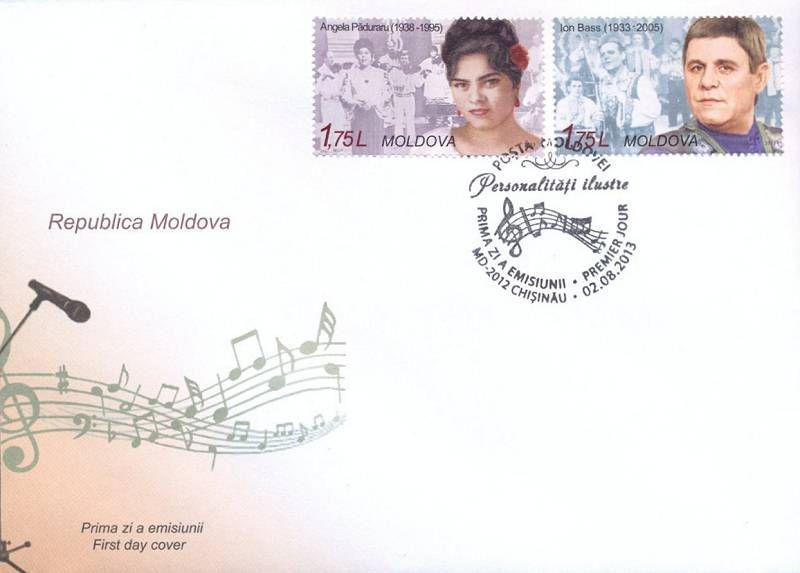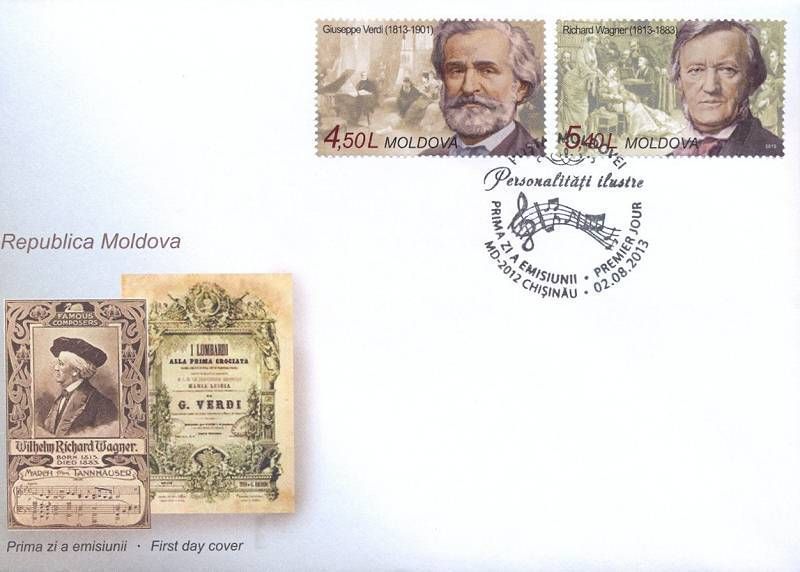POSTAGE STAMPS
|
|
Ion Bass (1933-2005), Folk Singer
- Michel Catalogue No: 844
- Perforation Type/Size: Comb 14:14.50
- Size: 46.00 x 27.50 mm
- Face Value: 1.75 Lei
- Quantity Printed: 50,000
|
|
| |
|
Angela Păduraru (1938-1995), Folk Singer
- Michel Catalogue No: 845
- Perforation Type/Size: Comb 14:14.50
- Size: 46.00 x 27.50 mm
- Face Value: 1.75 Lei
- Quantity Printed: 50,000
|
|
| |
|
Giuseppe Verdi (1813-1901), Composer
- Michel Catalogue No: 846
- Perforation Type/Size: Comb 14:14.50
- Size: 46.00 x 27.50 mm
- Face Value: 4.5 Lei
- Quantity Printed: 50,000
|
Giuseppe Fortunino Francesco Verdi (Italian: [d͡ʒuˈzɛppe ˈverdi]; 9 or 10 October 1813 – 27 January 1901) was an Italian Romantic composer primarily known for his operas. Verdi and Richard Wagner are considered the two preeminent opera composers of the nineteenth century. Verdi dominated the Italian opera scene after the eras of Bellini, Donizetti and Rossini. His works are frequently performed in opera houses throughout the world and, transcending the boundaries of the genre, some of his themes have long since taken root in popular culture, as 'La donna è mobile' from Rigoletto, 'Libiamo ne' lieti calici' (The Drinking Song) from La traviata, 'Va, pensiero' (The Chorus of the Hebrew Slaves) from Nabucco, the 'Coro di zingari' (Anvil Chorus) from Il trovatore and the 'Grand March' from Aida. Read more..
This article uses material from the Wikipedia article 'Giuseppe_Verdi', which is released under the Creative Commons Attribution-Share-Alike License 3.0. |
| |
|
Richard Wagner (1813-1883), Composer
- Michel Catalogue No: 847
- Perforation Type/Size: Comb 14:14.50
- Size: 46.00 x 27.50 mm
- Face Value: 5.4 Lei
- Quantity Printed: 50,000
|
Wilhelm Richard Wagner (/ˈvɑːɡnər/; German: [ˈʁiçaʁt ˈvaːɡnɐ]; 22 May 1813 – 13 February 1883) was a German composer, theatre director, polemicist, and conductor who is primarily known for his operas (or, as some of his later works were later known, 'music dramas'). Unlike most opera composers, Wagner wrote both the libretto and the music for each of his stage works. Initially establishing his reputation as a composer of works in the romantic vein of Weber and Meyerbeer, Wagner revolutionised opera through his concept of the Gesamtkunstwerk ('total work of art'), by which he sought to synthesise the poetic, visual, musical and dramatic arts, with music subsidiary to drama, and which was announced in a series of essays between 1849 and 1852. Wagner realised these ideas most fully in the first half of the four-opera cycle Der Ring des Nibelungen (The Ring of the Nibelung). Read more..
This article uses material from the Wikipedia article 'Richard_Wagner', which is released under the Creative Commons Attribution-Share-Alike License 3.0. |
| |







No comments:
Post a Comment